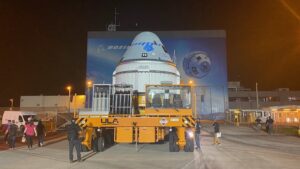Liftoff of the spacecraft on a United Launch Alliance Atlas 5 is scheduled for 2:53 p.m. Eastern that day. If the launch is postponed, the next opportunity is Aug. 3 because of range conflicts and orbital mechanics.
A launch July 30 would set up a docking attempt by the Starliner with the International Space Station about 24 hours later. Starliner would remain docked to the station until Aug. 5, undocking and landing later that day at White Sands Space Harbor in New Mexico.
The OFT-2 mission will come more than a year and a half after the original OFT flight in December 2019. Software problems encountered immediately after the spacecraft separated from its Centaur upper stage prevented it from going to the ISS, and it instead landed after just two days in space.
The flight readiness review confirmed that Boeing had implemented 61 recommendations from an independent review team last year about software issues during the OFT mission as well as 19 recommendations to address communications problems encountered during the flight. “Those have been closed out,” Steve Stich, NASA commercial crew program manager, said in a call with reporters after the review.
Among the changes made preparing for OFT-2 was a full mission rehearsal for the flight in a high-fidelity simulator. “We truly had an integrated mission rehearsal, a simulated mission from end to end,” said John Vollmer, vice president and program manager of the commercial crew program at Boeing. “We got a lot of learning out of that.”
The mission plan for OFT-2 will be very similar to what had been planned for OFT, Vollmer said. One change is that the spacecraft will maneuver shortly after Centaur separation to better orient its antennas for communications during that critical early phase of the mission.
The launch plans should not be affected by issues with Nauka, a new Russian module for the ISS launched July 21. That module has reportedly suffered issues with its propulsion system, although Roscosmos reported July 22 that the module has performed two maneuvers to raise its orbit. Nauka is scheduled to dock with the station July 29.
“We’ve been working with Roscosmos to set up that choreography,” said Joel Montalbano, NASA ISS program manager. While not going into details about any issues with Nauka, also known as the Multipurpose Laboratory Module (MLM), he said that “we can support the OFT docking with or without the MLM.”
A successful OFT-2 mission would allow NASA and Boeing to proceed with the Crew Flight Test (CFT), the first crewed Starliner mission that will carry three NASA astronauts. Stich said that the CFT mission could take place “as soon as later this year” but declined to offer a more specific date. Some industry sources are skeptical that CFT could launch this year, even if OFT-2 launches on schedule and is successful.
“The most important thing, and the thing that the Boeing and NASA team have been focused on in the near term, is the execution of the orbital flight test. That has been our primary focus,” he said. Only after OFT-2 is complete and the data from it analyzed would NASA feel comfortable about setting a date for a crewed mission. “It looks like, right now, by the end of the year would be supportable, but again, we need to focus on the orbital flight test first and get that flight right.”
One factor that could accelerate the schedule for CFT is that the Starliner flying OFT-2 is closer to the configuration for the crewed flight than the one used on the previous flight. That includes installing the launch abort thrusters that would allow Starliner to escape the rocket in the event of an emergency.
NASA is anxious to get Starliner into service, providing redundancy for getting its astronauts to and from the ISS, a burden currently carried by SpaceX’s Crew Dragon spacecraft. “It’s very important for the commercial crew program to have two space transportation systems,” Stich said.
The flight is also critical to Boeing, Vollmer acknowledged. “It’s extremely important to us that we’re successful on this flight. With all that we’ve done over the past 18 months, we are very confident that we are going to have a good flight,” he said.
He added, though, that he expected there to be “some learning” from OFT-2. “It is a test flight,” he said. “It is of paramount importance that we have a successful flight.”



